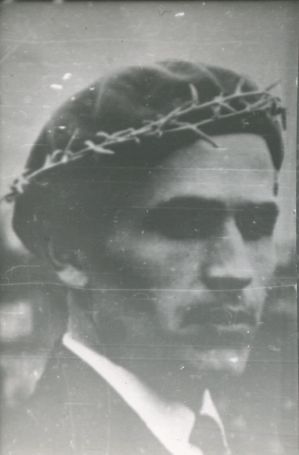MY AUTOBIOGRAPHY
I was born on November 28, 1937, into the family of a Greek Catholic priest in the village of Ostapie in the Ternopil region. I received my primary education in my native village. But due to the arrest of my father, who categorically refused to renounce his ancestral faith and convert to Moscow-KGB Orthodoxy, I was forced to survive on the kindness of good people. My mother, Yelysaveta née Rachkovska, despite having a university education and speaking six languages, was not allowed to work as a teacher even in primary school. But, despite the unfavorable living conditions, with God's help all five children (three sisters and a brother) managed to attain higher education on their own.
After graduating from secondary school in 1954, I entered the Stanyslaviv two-year technical school, where I received a secondary technical education and found a job in the garage of the Kosiv forestry enterprise. I was then drafted and served a three-year military service.
After demobilization in 1960, I enrolled in the Kyiv Medical Institute in the dentistry faculty. During my student years, I co-organized the institute's bandura chapel, participated in the work of the Club of Creative Youth of Kyiv, and organized Christmas caroling groups.
During the summer vacation of 1964 in the Carpathians, I learned about the destruction of the Shevchenko monument in the village of Sheshory in the Kosiv region by Hungarian troops during the war and the unsuccessful efforts of the village council head, Mr. Volodymyr Mykhailiuk, to restore it. Having good relations with the Honored Sculptor of Ukraine Ivan Honchar, I decided to help with the reconstruction of the monument. So, with the active participation of sculptor Ivan Honchar and architect Hryhoriy Kovbasa, the project documentation and a bust of Shevchenko were created. In turn, the residents of Sheshory restored the grave mound and the pedestal for the bust.
After the monument was installed and a large gathering of people was planned, the Soviet authorities banned the unveiling of the monument on the designated day, and only a week later, when the ban had been made known not only to the public of Ukraine but also to the diaspora, was the monument unveiled.
After the unveiling of the monument, while returning to my studies in Kyiv, I was arrested on the road by the KGB, taken to the Kyiv central prison, and after a seven-month stay in a solitary confinement cell for investigation and endless interrogations, I was convicted of so-called “anti-Soviet agitation and propaganda” and served a three-year sentence in the strict-regime Mordovian concentration camps.
After my release in 1968, I was forbidden to live in Ukraine (they wouldn't register me anywhere). So I was forced to register in Russia, and with the help of dissidents, I was reinstated to finish medical school in Smolensk. After graduation, I received an assignment to the Penza province. Ignoring the assignment, I went to Turka in the Lviv region, where my wife worked as a doctor. With the assistance of the chief physician of the Central Regional Hospital, Mr. Stanislav Horlenko (by the way, the only non-party chief physician in the region), I got a job in the village of Limna, but a month later I was forced to leave the village, which was in the border zone: persons with a stamp in their passport “Regulations on Passports” did not have the right to reside there. But the chief physician, ignoring the demands of the authorities, did not fire me but transferred me to work in the village of Yasenytsia (Yasinka-Masiova), and later to the Turka Central Regional Hospital as the district dentist. I had a problem with registration, and only after two years was I registered with difficulty in the city of Turka. I worked in the Turka region for 30 years.
During Gorbachev's “perestroika” years, I became involved in the socio-patriotic life of Boikivshchyna, organized a competition of verteps (25 verteps), participated in the creation of the Ukrainian Language Society and headed it, was a co-chairman of Rukh and “Memorial.”
The first democratic elections to councils of all levels were held actively in the Turka region, in which I was elected a deputy of the regional and district councils. In 1994, a branch of the Congress of Ukrainian Nationalists (KUN) was established in the district, and I was entrusted to lead it. With the active help of fellow party members, we managed to create KUN branches in almost all villages of the district, which greatly contributed to raising the national consciousness among the population of the district.
After the creation of the “Boikivshchyna” Society, I took an active part in conducting cultural events as a member of the Society's leadership.
For my active patriotic and educational work and participation in the cultural revival of Boikivshchyna, I was awarded the “10 Years of Ukrainian Independence” medal, and at the Third Boiko Fest, I was awarded the “Honorary Boiko” certificate.
In 2000, I retired and, for family reasons, moved to the USA. But even in a foreign land, I tried to work for the benefit of the Boiko Land: I published materials about the life of Boikivshchyna in American Ukrainian periodicals and, first and foremost, informed the Ukrainian diaspora about the Boiko Fests and the World Congress of Boikos.
Having joined the work of the “Boikivshchyna” Society of America and Canada, on September 16, 2006, I was elected chairman of the Society's Main Board at the general meeting.
My wife, Lesia née Sandurska, works as a neurologist in Lviv; my daughter, Olya Kachai (by marriage), works as a doctor in the state of New Jersey, USA.
Yaroslav Hevrych.
(2007).
Transcribed from manuscript by Vasyl Ovsiienko, Kharkiv Human Rights Protection Group, July 18, 2009.
In the photo: Yaroslav Hevrych in a crown of thorns.
